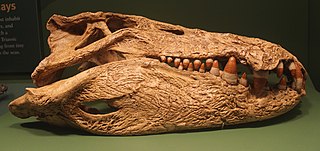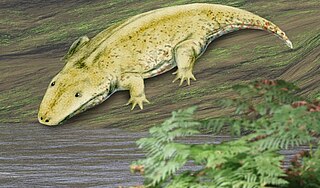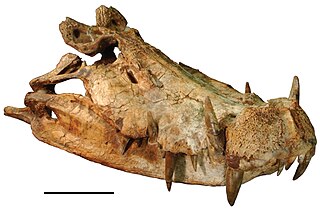
Mahajangasuchus is an extinct genus of crocodyliform which had blunt, conical teeth. The type species, M. insignis, lived during the Late Cretaceous; its fossils have been found in the Maevarano Formation in northern Madagascar. It was a fairly large predator, measuring up to 3 m (9.8 ft) with a weight up to 360 kg (790 lb).
Elosuchus is an extinct genus of neosuchian crocodyliform that lived during the Middle Cretaceous of what is now Africa.
Calsoyasuchus is a genus of goniopholidid mesoeucrocodylian that lived in the Early Jurassic. Its fossilized remains were found in the Sinemurian-Pliensbachian-age Kayenta Formation on Navajo Nation land in Coconino County, Arizona, United States. Formally described as C. valliceps, it is known from a single incomplete skull which is unusually derived for such an early crocodile relative. This genus was described in 2002 by Ronald Tykoski and colleagues; the species name means "valley head" and refers to a deep groove along the midline of the nasal bones and frontal bones.

Saharastega is an extinct genus of basal temnospondyl which lived during the Late Permian period, around 251 to 260 million years ago. Remains of Saharastega, discovered by paleontologist Christian A. Sidor at the Moradi Formation in Niger, were described briefly in 2005 and more comprehensively in 2006. The description is based on a skull lacking the lower jaws.
Rugosuchus is an extinct genus of neosuchian crocodyliform from the late Early Cretaceous of China. It is known from most of a skull, a partial postcranial skeleton, and a second partial skeleton including part of the hips. It was described by Xiao-Chun Wu and colleagues in 2001, with R. nonganensis as the type species. At the time of its description, it was the most complete crocodyliform from northeastern China, and only the second known.

Konzhukovia is an amphibian genus that belongs to an extinct group of temnospondyls, the largest clade of basal tetrapods including about 198 genera, 292 species, and more than half of which were alive during the early Mesozoic period. The animal was a predator that lived about 260 million years ago, and could get up to about 3 meters in length. Specifically, Konzukovia lived during the Permian, between 252 and 270 million years ago according to the type of rock the fossil was found in. There are three species within this genus, K. vetusta, K. tarda, and K. sangabrielensis, the first two originating from Russia while the latest originating from Southern Brazil. The discovery of this specimen in Southern Brazil provided more evidence to support the idea that during this animals existence, there was a “biological corridor” because of the supercontinent Pangea, allowing these species to be found so far apart from each other. Konzhukovia belongs to the family Archegosauridae, a family consisted of large temnospondyls that most likely compare to modern day crocodiles. Since the discovery of the latest species, K. sangabrielensis Pacheco proposes that there must be the creation of a new family, Konzhokoviidae, a monophyletic group in a sister-group relationship with Stereospondlyi in order to accommodate the three species. Konzhukovia skulls usually exhibit typical rhinesuchid features including an overall parabolic shape, small orbits located more posteriorly, and the pterygoids do not reach the vomer. These animals were long-snouted amphibians that had clear adaptations made for fish catching, as well as exemplifying aquatic features.
Neosuchia is a clade within Mesoeucrocodylia that includes all modern extant crocodilians and their closest fossil relatives. It is defined as the most inclusive clade containing all crocodylomorphs more closely related to Crocodylus niloticus than to Notosuchus terrestris. Neosuchia is very diverse and may be polyphyletic, as the clade has undergone many revisions since it was first named in 1988. Members of Neosuchia generally share a crocodilian-like bodyform adapted to freshwater aquatic life, as opposed to the terrestrial habits of more basal crocodylomorph groups. The earliest neosuchian is suggested to be the Early Jurassic Calsoyasuchus, which lived during the Sinemurian and Pliensbachian stages, often identified as a member of Goniopholididae, though this is disputed, and the taxon may lie outside Neosuchia, which places the earliest records of the group in the Middle Jurassic.
Stolokrosuchus is an extinct genus of neosuchian crocodylomorph that lived during the Early Cretaceous. Its fossils, including a skull with a long thin snout and bony knobs on the prefrontal, have been found in Niger. Stolokrosuchus was described in 2000 by Hans Larsson and Boubacar Gado. The type species is S. lapparenti. They initially described it as related to Peirosauridae, if not a member of that family. One study has shown it to be related to Elosuchus. However, more recent works usually find Stolokrosuchus to be one of the basalmost neosuchian, only distantly related to the elosuchid or pholidosaurid, Elosuchus.

Kaprosuchus is an extinct genus of mahajangasuchid crocodyliform. It is known from a single nearly complete skull collected from the Upper Cretaceous Echkar Formation of Niger. The name means "boar crocodile" from the Greek κάπρος, kapros ("boar") and σοῦχος, soukhos ("crocodile") in reference to its unusually large caniniform teeth which resemble those of a boar. It has been nicknamed "BoarCroc" by Paul Sereno and Hans Larsson, who first described the genus in a monograph published in ZooKeys in 2009 along with other Saharan crocodyliformes such as Anatosuchus and Laganosuchus. The type species is K. saharicus.

Paralligatoridae is an extinct family of neosuchian crocodyliforms that existed during the Jurassic and Cretaceous periods. It includes the genera Paralligator, Brillanceausuchus, Kansajsuchus, Shamosuchus, Scolomastax, Sabresuchus, Rugosuchus, Batrachomimus and Wannchampsus, as well as the yet-unnamed "Glen Rose form".
Sebecosuchia is an extinct group of mesoeucrocodylian crocodyliforms that includes the families Sebecidae and Baurusuchidae. The group was long thought to have first appeared in the Late Cretaceous with the baurusuchids and become extinct in the Miocene with the last sebecids, but Razanandrongobe pushes the origin of Sebecosuchia to the Middle Jurassic. Fossils have been found primarily from South America but have also been found in Europe, North Africa, Madagascar, and the Indian subcontinent.
Sunosuchus is an extinct genus of goniopholidid mesoeucrocodylian. Fossils are known from China, Kyrgyzstan, and Thailand and are Jurassic in age, although some may be Early Cretaceous. Four species are currently assigned to the genus: the type species S. miaoi and the species S. junggarensis, S. shartegensis, and S. shunanensis. All species are from China. Goniopholis phuwiangensis, also from Thailand, was reassigned to Sunosuchus by Andrade et al. (2011). The material from Kyrgyzstan has not been assigned to any species.

Susisuchus is an extinct genus of neosuchian mesoeucrocodylian crocodyliform from the Early Cretaceous of Brazil. Fossils have been found from the Nova Olinda Member of the Aptian-age Crato Formation in the Araripe and Lima Campos Basins of northeastern Brazil. Named in 2003, Susisuchus is the sole member of the family Susisuchidae, and is closely related to the clade Eusuchia, which includes living crocodilians. The type species is S. anatoceps, known from a single partial articulated skeleton that preserves some soft tissue. A second species, S. jaguaribensis, was named in 2009 from fragmentary remains.

Pissarrachampsa is an extinct genus of baurusuchid mesoeucrocodylian from the Late Cretaceous of Brazil. It is based on a nearly complete skull and a referred partial skull and lower jaw from the ?Campanian - ?Maastrichtian-age Vale do Rio do Peixe Formation of the Bauru Group, found in the vicinity of Gurinhatã, Brazil.

Pissarrachampsinae is a subfamily of baurusuchid crocodyliforms from the Late Cretaceous of Brazil and Argentina. It was named in 2011 with the description of Pissarrachampsa sera and includes P. sera from Brazil and the related Wargosuchus australis from Argentina. Pissarrachampsinae is one of two subfamilies of Baurusuchidae, the other being Baurusuchinae.

Caipirasuchus is an extinct genus of sphagesaurid notosuchians known from the Late Cretaceous of northern São Paulo State, southeastern Brazil. The type species, C. paulistanus, was named in 2011. A second species, C. montealtensis, was referred to Caipirasuchus in 2013 after having been named in 2008 as a species of Sphagesaurus. A third species, C. stenognathus, was described in 2014. A fourth species, C. minerius, was described in 2018. A fifth species, C. attenboroughi, was named in 2021 in honour of David Attenborough.
Paluxysuchus is an extinct genus of neosuchian crocodyliform known from the Early Cretaceous Twin Mountains Formation of north-central Texas. It contains a single species, Paluxysuchus newmani. Paluxysuchus is one of three crocodyliforms known from the Early Cretaceous of Texas, the others being Pachycheilosuchus and an unnamed species referred to as the "Glen Rose Form". Paluxysuchus has a long, flat skull that is probably transitional between the long and narrow skulls of many early neosuchians and the short and flat skulls of later neosuchians.

Coelognathosuchia is an extinct clade of neosuchian crocodyliforms that includes all taxa more closely related to the family Pholidosauridae than to Bernissartia fagesii or Eusuchia. Martin et al. (2014) named the clade after finding goniopholidids and pholidosaurids to group together in their phylogenetic analysis of crocodyliform evolutionary relationships. In their analysis, Pholidosauridae was monophyletic and Goniopholididae was paraphyletic, being an assemblage of successively more basal taxa within Coelognathosuchia. Coelognathosuchia itself was positioned near the base of the larger clade Neosuchia as the sister group to a clade containing the Early Cretaceous neosuchian Bernissartia and Eusuchia, the group that includes all modern crocodilians and their closest extinct relatives.

The Pastos Bons Formation is a Late Jurassic geologic formation of the Parnaíba Basin in Maranhão, northeastern Brazil. The formation forms part of the sag phase of the basin. It overlies the Sardinha Formation and is overlain by the Mosquito Formation. The fluvial to lacustrine sandstones and shales have provided fossils of a coelacanth fish, Parnaibaia maranhaoensis and a paralligatorid named after the formation, Batrachomimus pastosbonensis.
Rastosuchus is an extinct genus of stereospondyl temnospondyl within the family Rhinesuchidae. It contains one species, Rastosuchus hammeri, found in the Permian Rio do Rasto Formation of Brazil.













